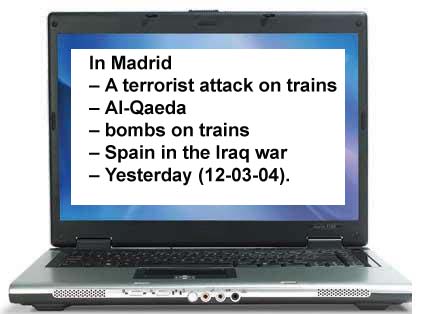2.2 The 6 W's
En la introducción de este apartado hemos mencionado un test que se hace para comprobar que una noticia está adecuadamente redactada. Se trata de que su contenido responda a las seis preguntas del periodista. Analicemos cada una de ellas para que aprendas a redactar una noticia como un auténtico/a profesional.
.
THE SIX W's
.
Cuando decimos que estamos leyendo el periódico en realidad lo que hacemos es leer los titulares y sólo cuando hay un titular que nos llama la atención, nos provoca curiosidad o sencillamente trata de algún asunto que nos interesa, es cuando pasamos a leer el contenido de la noticia en su totalidad.
.
¿Qué son las seis W? Pues se refieren a los pronombres interrogativos WHAT, WHO, WHERE, WHEN, WHY y HOW. En otras palabras, cuando el periodista redacta la noticia ha de proporcionar información de modo que se respondan las que se llaman "las preguntas del periodista":
.
- What? - ¿Qué ha sucedido? (Los hechos)
- Who? - ¿Quién/ quienes son los protagonistas de la noticia? (Los sujetos)
- Where? - ¿Dónde ha ocurrido? (El lugar)
- When? - ¿Cuándo? (El tiempo)
- Why? - ¿Por qué ha ocurrido? (La causa)
- How? - ¿Cómo? (El modo)
Comprueba lo aprendido
Ahora vamos a hacer un ejercicio para reconocer las seis W en una noticia. Te vamos a poner la tarea lo más fácil posible ya que vamos a responder a las seis W en una crónica periodística.
Desgraciadamente España sufrió un dramático atentado terrorista el 11 de marzo de 2004 en Madrid. Durante varios días, cientos de periodistas, tanto españoles como extrajeros, acudieron a ruedas de prensa para ser informados de lo ocurrido. El corresponsal (correspondent) de un periódico británico elaboró la siguiente crónica a partir de los apuntes tomados en una rueda de prensa.
Lee y escucha. Después, responde a las cuestiones planteadas.
 |
.
Spanish national mourning. Friday 12 March 2004 After yesterday's bomb attacks in Madrid, the Spanish public are suffering together in three days of national mourning. The bombs on the trains killed nearly 200 people. In newspaper articles, radio and television announcements and even mobile phone messages, Spaniards are encouraging one another to take part in a planned mass demonstration this evening to protest against terror and yesterday's bloody attacks. Across Spain, people held candlelit vigils in the night, expressing their sympathy with the numerous victims. The Spanish government has called for three days of national mourning. Meanwhile the official investigation and public speculation into who was behind the atrocity continues. Intelligence officials here say there's evidence pointing at an Islamist organisation linked to al-Qaeda, because of the involvement of Spain in the Iraq war.
|
| 11 de marzo, Madrid Imagen de Juan Antonio Capó Alonso en Flickr. Licencia CC |
VOCABULARY HELP
.
|
Together: juntos/as Mourning: luto Nearly: casi, cerca de Encourage: animar Mass: masivo/a Demonstration: manifestación |
Against: contra Bloody: sangriento/a Across: a lo largo de Candlelit vigils: vigilias con velas Call for: decretar Involvement: participación |
Durante la rueda de prensa (press meeting), el corresponsal fue tomando apuntes en su portátil. A partir de estas notas rápidamente redactó la crónica que acabas de leer y sin perder tiempo la envió por email a la redacción de su periódico en Londres utilizando la conexión de internet móvil de su ordenador. Mira los apuntes más relevantes de la noticia.

Practiquemos un poco más con las seis W (al fin y al cabo lo que estamos haciendo es captar la información más relevante de un texto). Lee y escucha:
.
.
.
| Paris.- By correspondent Susan Jacobs
Yesterday, at the National Assembly, the President of the French Republic presented the Government decisions to solve the country's economic situation. The most alarming problems are the fall of industrial production and private consumerism. The reason for this dramatic fall is the difficulty to find loans from banks. In order to solve these problems, the Government will lend 75,000 million euros to banks so that companies and individuals can have an easy and fast access to loans. |
Comprueba lo aprendido
Con esto, hemos terminado con el tema 2. Recuerda anotar todo el vocabulario nuevo en tu cuaderno y realizar los ejercicios de la sección Para aprender, hazlo tú que hay al final del tema.